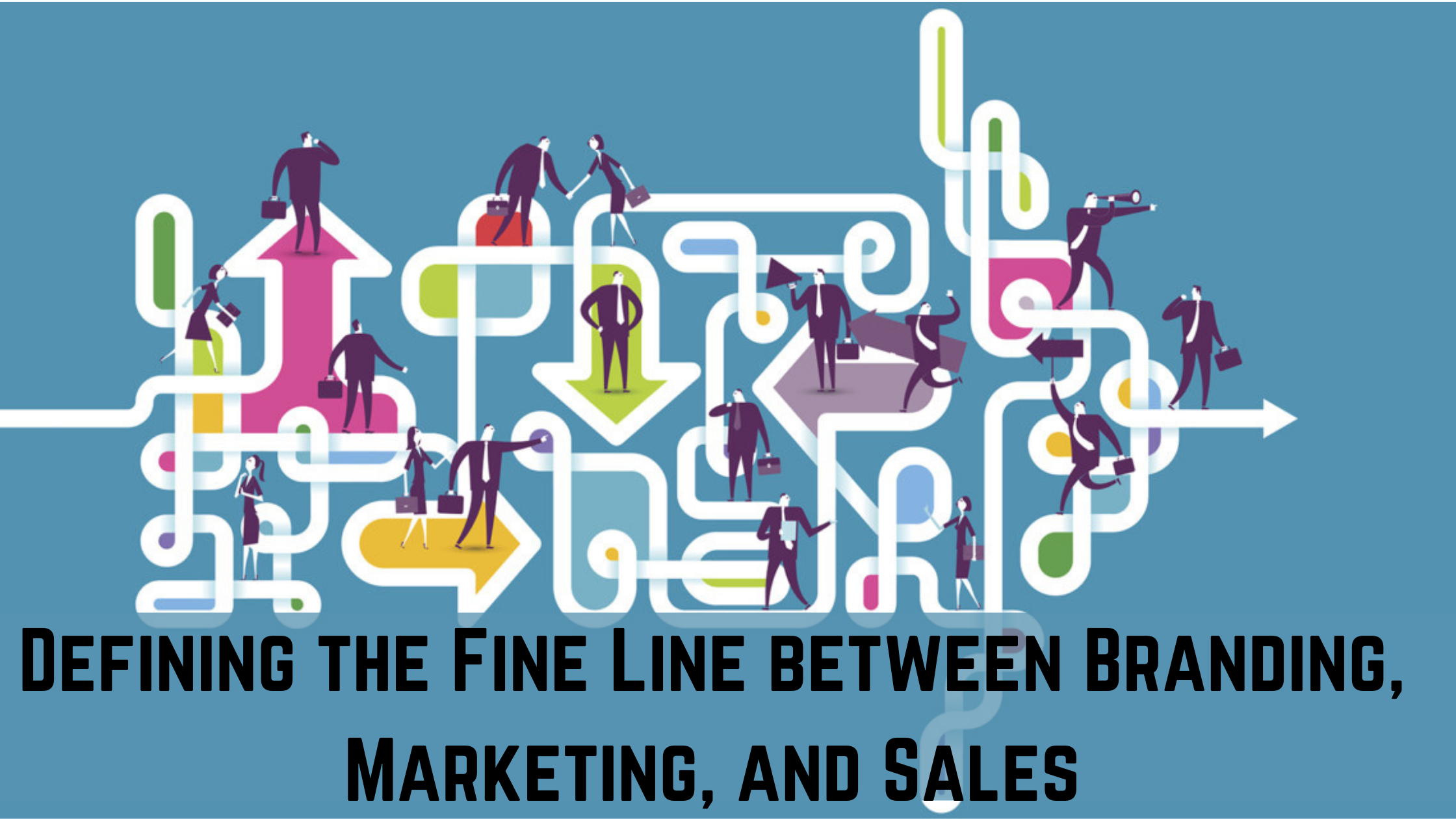Table of Contents
Branding, marketing, and sales – these are the three buzzwords you can hear so often today. Do you use them interchangeably without even having a clear understanding of the distinct purposes these activities serve for your brand?
Worse even, some entrepreneurs are in the illusion that these are different activities without any interrelation. But here’s a reality check for you!
You need to have a crystal clear knowledge of these concepts to develop a rock-solid success strategy for your business. So without beating around the bush, let’s dive straight into the differences between Branding and marketing vs. sales.
The Basic Point Of Difference Between Branding, Marketing, And Sales
Branding
This is the personality or identity of your business. What purpose does it serve? Why should people care? Branding is everything that creates a perception of your company in your target customer’s mind, and it is what converts your business into a “brand”.
Marketing
Marketing refers to the tactics you use for your business to get noticed by more and more people across different platforms. It could be a Facebook ad campaign you are running or a blog on your website, and strategic marketing inspires people to gain interest in your company offerings.
Sales
A sale is the final and the most crucial stage where you compel the customer to hit that “buy now” button. But it isn’t an independent element by itself, and a sale happens due to branding and marketing.
However, none of these activities is independent of each other. Your marketing campaigns influence your branding, and your branding and marketing activities significantly impact your sales and so on.

Here’s A Quick Example For You To Get The Distinction And Relation Between These Activities Better:
For instance, you run an online business that sells doughnut boxes. So you launch a website from where people can buy your boxes. You also set up an Instagram page to promote these boxes.
Imagine that you want your business to be perceived as a brand that is “cute”, “playful”, and “fun”. Now, these three terms are your branding strategy, and you have to design your marketing strategy to complement your branding strategy strategically.
For instance, your Instagram can be full of witty and quirky posts related to doughnuts. You can even include meme content related to doughnuts. The overall aesthetic can be full of bright and cute shades.
On your website, you can choose a similar “fun” color scheme. Your website copy can be crisp and engaging with a funny tone. You can even send a thank you note with every box that has a sense of humor.
All of these are directly or indirectly marketing activities that will contribute to your branding vision.
Now, the sales you make will depend on what impact these strategies create on your potential customers’ minds (apart from the taste of the doughnuts). After the entire process, what customers think about your business is your branding.
Now that you have a fair idea of these terms, let’s dig deeper.
Branding Vs Marketing Vs Sales
Branding
Branding at its core is about displaying how your brand can add value to the lives of people. It is about assessing the needs and aspirations of your target customers so that you can show them how your brand can solve their problems.
Most entrepreneurs and marketers have a misconception that branding is all about their brand, and the reality is that any brand is about what customers think about and want from a brand.
For instance, it does not matter if Zara brands itself as luxury apparel, and its buyers and prospects need to perceive it as “luxury.”
But at the end of the day, your customer’s perception widely depends on how you market your brand. Every single visual and verbal element plays a big role in branding.
Make the best use of these elements to tell the story of your brand. It is also crucial that your brand has its own beliefs and values. Use your brand’s social media handles, logo, website, ads, etc., to communicate them.
Marketing
Marketing is all about getting your brand out there in the world. There is an ocean of brands right now, and the only way to stand out is through exceptional marketing strategies.
Your company’s branding and sales are bound to fall out if your marketing isn’t in place.
Remarkable marketing strategies are about building the credibility of your brand and creating interest and awareness among the people.
Curate your marketing campaigns in such a way that they convey your brand’s value.
But does that mean you need every other marketing tool out there? Absolutely, no!
Customize your marketing toolbox according to your brand’s goals. Starting a newsletter because several other brands are doing it may not necessarily get you the conversions you need.
Sales
You might find a sale as an inevitable outcome after branding and marketing strategies are successfully applied. However, it doesn’t work that way! Your brand needs a suitable sales strategy as well.
The entire purpose of a business lies in making sales. So it would help if you strategized to generate relevant leads in your pipeline.
But, how do you create a successful sales strategy?
By re-assessing your branding and marketing strategies.
- Are your social media campaigns driving enough leads to your website?
- If not, what needs to change?
- Are your newsletters generating enough revenue?
- If not, what can be a better marketing tool for your brand?
Your sales strategy should be all about figuring out which marketing and branding strategies give you maximum results. After that, invest time and money in the strategies that work best.
“Marketing can get a customer’s attention, while branding keeps their attention.”
To put it simply, marketing is the strategy that makes your brand visible to the world, and it helps your brand break through the clutter and grab eyeballs.
But branding is responsible for grabbing your customer’s attention and keeping them interested. Branding connects people to your business in the long run, even without marketing.
Your customers might know about your brand’s existence (due to great marketing strategies) but still not love your brand (due to poor branding strategies).
If your goal is to generate sales faster, your focus should be more on rock-solid marketing strategies. But if your goal is to build brand credibility, brand loyalty, brand recognition, etc., in the longer run, you cannot compromise on strategic branding techniques.
Here Are Some Key Points Of Difference:
Branding Is The First Step; Marketing Is The Second Step.
Only when you have a complete picture of what your brand represents, you can move on to marketing. Define your brand’s purpose, values, and tone before you curate any campaign.
Marketing without branding is similar to throwing shots in the air. What will you market if you don’t have a brand?
Marketing Campaigns Are Temporary, But Branding Is Forever.
Marketing campaigns use a variety of creative tactics to attract attention to your brand. These ideas constantly change and evolve, but your branding at its core will remain the same.
Branding will define how your audience perceives you, and once perception is created, it stays.
Marketing Is More Of A Push Strategy, But Branding Is A Pull Strategy.
Now, what are push and pull strategies?
A push marketing strategy pushes the product onto the consumer. This technique is used to gain and improve product exposure by making value or quality its central theme. For instance, a packaging design might encourage the consumer to buy the product. Alternatively, email marketing paid ads and limited-time offers represent push marketing strategies.
A pull marketing strategy is a promotional strategy that pulls the consumers toward your brand. The aim is to enhance demand in the market by making the consumer actively want your product. For instance, search engine optimization activities, media coverage, active word-of-mouth references, social media networks, and sometimes even email marketing are used. Email marketing can be used in a push or pull marketing, depending on your communication.
Now that you understand the difference between push and pull marketing strategies, you can easily define the best route for you.
We can even look at the common branding and marketing strategies of popular brands to understand the difference.

Branding Strategy Of Popular Brands
Apple
Apple does not sell a phone, Macbook, or tablet; it sells a high-end lifestyle. Their branding strategy is to be perceived as a revolution-creator. Have you ever noticed their ad taglines? “Think Different”.
This tagline creates a perception that Apple users are superior to any other brand user. Premium white packaging, glamorous launch events, exclusive ads; everything has the power to create a high impact on the minds of people.
No wonder this brand has a massive dedicated fandom in itself that defends the brand. There can be the slightest change from one model to another, but people still want the same brand! They feel the need to own Apple products for a better life. Now that’s branding!
McDonald’s
McDonald’s has food chains all over the world. So their branding game is all about consistency. Over the years, they have been using the same golden arched letter “M” as their logo.
Even a five-year-old can recognize this brand by its logo. That’s their power of branding! They have proved to the world that you don’t need to bring in unnecessary changes in the name of innovation. They do, however, make sure to keep evolving from burger flavors to beverages.
Consistency is great! They have also kept the authenticity of their original products intact with some thoughtful improvements. Their branding also makes people connect McDonald’s with the emotion of happiness through products like “happy meal” and a tagline like “I’m Lovin’ It” and the brand’s color yellow.
Dominos
Dominos is ruling the Indian market with its core branding strategies of “quick service” and “affordability. Their 30-minute delivery rule shows that they care about their customers and value their time.
Their branding also lies in the fact that they never compromise on the quality of the pizza, no matter how low the price. They provide exciting offers and coupons to make it affordable among their young customers, the highest consumers of pizza.
The taste of the products is also suited to the local market’s preferences; for instance, Paneer Makhani, Chicken Tikka, etc.
Dove
Dove’s branding is all about “creating a positive experience of beauty accessible to every woman”. Women mostly use their products, and so their brand tone is widely feminist.
Most of their campaigns are about creating awareness on women being comfortable in their skin, raising self-esteem, self-love, and other agendas crucial to women.
Their branding strategy, unlike most beauty products, is not to promise women exceptional beauty standards. Instead, their brand reflects diverse beauty through its “Real Beauty Pledge”.
Marketing Strategy Of Popular Brands
Coca-Cola: Share Happiness
Can you name one person who has not heard about their “Share a Coke” campaign? Coca-Cola’s core marketing strategy is associating the brand with positive emotions like “happiness” and “kindness”.
Their campaigns have a “personal touch” that makes their customers feel more involved with the brand. Their marketing creates a perception in young minds that sharing a Coke is a great way to bond and make new friends.
Netflix: Best Entertainment
Netflix markets itself as a brand leader in the world of quality content. Their marketing strategy is all about giving their audience that “adrenaline rush” by announcing new shows and movies.
Their social media is trendy, attention-seeking, and super casual. This strategy makes their brand appealing to the youth, the highest content consumers on this streaming platform.
Do you remember their famous “Netflix is a Joke” billboard? It got so many fans talking and so much media coverage! Their marketing goal is to resonate with people and elicit emotions.
Sephora: Premium And Sophisticated
Sephora’s core marketing strategy revolves around content marketing. Their keyword-rich content ranks their brand higher on search engines to build authority and position.
For instance, their email marketing campaigns are super-personalized. They provide product recommendations, and related offers and deals customized to the preferences of individual customers.
Their “Beauty Insider Community” is also a great marketing strategy to enhance a “premium” feel. It allows the members to connect with beauty experts and gain access to special events.

How Can Your Sales And Marketing Team Work Together To Produce Great Results For Your Brand?
“The basic difference between sales and marketing is that marketing owns the message and sales own the relationship.”
Though sales and marketing are essentially different activities, at the core, both have the same goals, i.e. creating revenue for your brand.
Statistics show that “collaboration between sales and marketing teams can result in 38% higher win rates and 36% better customer retention”.
Here are some areas where your sales and marketing team can brainstorm and work together.
- Identifying friction points in the sales funnel
The sales funnel has parts where both the sales and marketing teams need to work together.
Take the feedback of both teams on how to improve the funnel to generate more leads. Is there something the sales team can do better? Can the marketing team adopt better strategies?
Some of the common friction points are:
- A lack of IQLs (Information Qualified Leads) or MQLs (Marketing Qualified Leads):
An IQL refers to a lead that provides their contact information for getting helpful information. An MQL refers to the marketing team that successfully gains the interest of the IQL by solving their problem, turning the IQL into an MQL or warm lead.
These leads are found or generated at the entry-level stage of the funnel. Whether or not more tips enter the funnel depends on the marketing strategies.
- A lack of SQLs (Sales Qualified Leads): Also known as a hot lead, the SQL is found at the last or bottom level of the funnel. This process involves closing the deal with the lead and thereby making a lead sales qualified. More people will convert if the sales strategy is strong enough and the customer’s problem is solved effectively.
● Conflicting targets: Sometimes, the marketing team may push too many leads into the funnel that the sales team cannot handle. It leads to wasted leads, and both teams need to decide on an achievable target.
Research shows that up to “80% of the content created by the marketing team does not generate sales”. How can this problem be solved?
Marketers need to create content that solves purchase conflicts and bottom-of-the-funnel queries to convert more MQLs into SQLs, which is the end goal.
2. Defining the ideal lead
“Four in five leads never convert into sales.”
A lead that the marketing team has not adequately nurtured is a waste of time for the sales team. Better quality leads will help your brand hit those revenue goals faster.
But how do you define the ideal lead? Your sales and marketing team needs to collaborate to create detailed and highly descriptive buyer personas. What are the typical qualities of the people who mainly convert? What are their most significant pain points?
You can use the following tools for research:
● SurveyMonkey
● SurveyGizmo
● Service
● Crowdsignal
● Qualaroo
Identifying and understanding the buyer persona will automatically improve marketing content creation, sales follow-up, or any other activities for acquiring and retaining clients.

3. Get sales involved in content creation
Your sales team can often give your marketing team a goldmine of valuable content ideas that generate sales. Do you know the reason behind this?
Your salespersons have a better idea of where your leads get stuck during conversion. Believe it or not, they have a better idea about which content can give that final push to your prospects to finalize the buying process.
But your marketing team can present the content better with their creative skills.
Are you confident that now you know enough about branding, sales, and marketing? We have covered almost every aspect of these strategies in our e-book. We hope you can use these concepts to build a successful business.
Related Blogs
- Why Digital Marketing Is Important For Small Businesses?
- Ten Steps To Create A Robust Digital Marketing Strategy For Your Business
- Digital Transformation: How Technology Is Revolutionizing Marketing
- Transform Your Brand’s Image With These Digital Marketing Trends In 2023
- 10 Digital Marketing Strategies For B2B Businesses
- Everything You Need To Know About Creating A Business Profile That Generates Leads.
- Generate Leads Through Paid Marketing Techniques
- The Complete Guide To Building Your Personal Brand
- Why Marketing Strategy is Important
- Why Is Branding Important
- What are Business Goals? Step-by-Step Guide
- Managing Sales Team To Target Customers And Beyond






Pingback: Branding Vs Marketing Vs Sales | TNW | Scoop.it
Pingback: Why Digital Marketing Is Important For Small Business
Pingback: Digital Transformation: How Technology Is Revolutionizing Marketing - Digitalz Pro Media & Technologies (P) Ltd
Pingback: Why Is Branding Important - Digitalz Pro Media & Technologies (P) Ltd
Pingback: What are Business Goals? Step by Step Guide - Digitalz Pro Media & Technologies (P) Ltd
Pingback: Managing Sales Team To Target Customers And Beyond - Digitalz Pro Media & Technologies (P) Ltd
Pingback: Generate Leads Through Paid Marketing Techniques